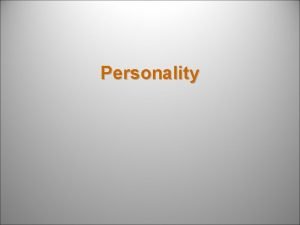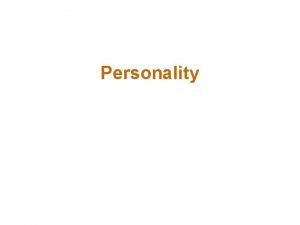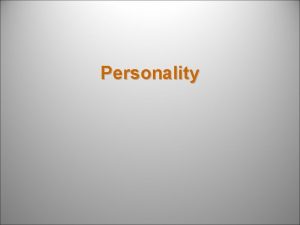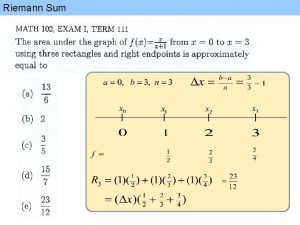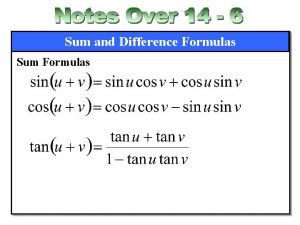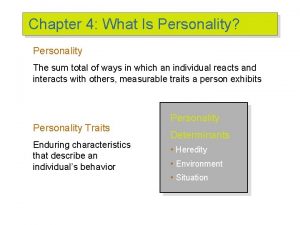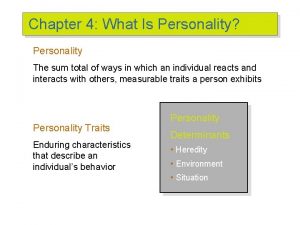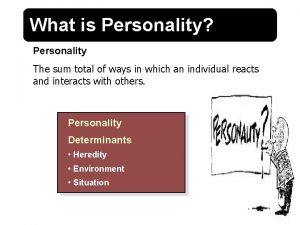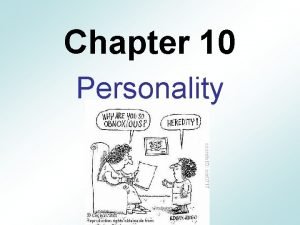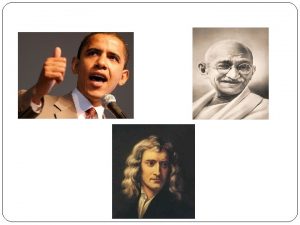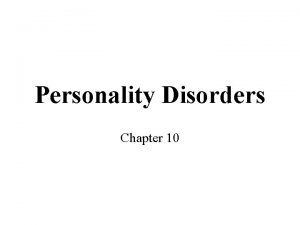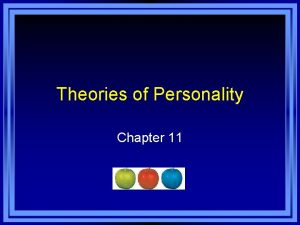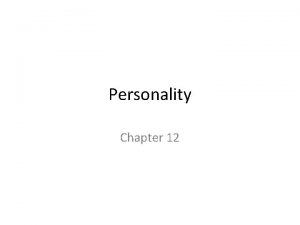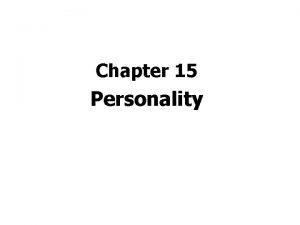Chapter 4 What Is Personality Personality The sum






































- Slides: 38

Chapter 4: What Is Personality? Personality The sum total of ways in which an individual reacts and interacts with others, measurable traits a person exhibits Personality Traits Enduring characteristics that describe an individual’s behavior Personality Determinants • Heredity • Environment • Situation

The Myers-Briggs Type Indicator (MBTI) A personality test that taps four characteristics and classifies people into 1 of 16 personality types Personality Types • Extroverted vs. Introverted (E or I) • Sensing vs. Intuitive (S or N) • Thinking vs. Feeling (T or F) • Judging vs. Perceiving (P or J) Score is a combination of all four (e. g. , ENTJ)

Meyers-Briggs (cont’d) A Meyers-Briggs Score – Can be a valuable too for self-awareness (i. e. , teambuilding and workplace communication) and career guidance – It is *VERY* popular in industry and widely used BUT – It should not be used as a selection tool because it has not been related to job performance!

The Big Five Model Extroversion Sociable, gregarious, and assertive Agreeableness Good-natured, cooperative, and trusting Conscientiousness***(VIP) Responsible, dependable, persistent, and organized Emotional Stability Calm, self-confident, secure under stress (positive), versus nervous, depressed, and insecure under stress (negative) Openness to Experience Curious, imaginative, artistic, and sensitive

Values Ø Definition: Mode of conduct or end state is personally or socially preferable (i. e. , what is right and good) Ø Value System: A hierarchy based on a ranking of an individual’s values in terms of their intensity Ø Values tend to be relatively stable and enduring Ø Provide understanding of the attitudes, motivation, and behaviors of individuals and cultures Ø Influence our perception of the world around us

Types of Values Terminal Values Desirable end-states of existence; the goals that a person would like to achieve during his or her lifetime Instrumental Values Preferable modes of behavior or means of achieving one’s terminal values

Achieving Person-Job Fit Personality-Job Fit Theory (Holland) Identifies six personality types and proposes that the fit between personality type and occupational environment determines satisfaction and turnover Personality Types • Realistic • Investigative • Social • Conventional • Enterprising • Artistic

Chapter FIVE Perception and Individual Decision Making

What Is Perception, and Why Is It Important? Perception A process by which individuals organize and interpret their sensory impressions in order to give meaning to their environment. • People’s behavior is based on their perception of what reality is, not on reality itself. • The world as it is perceived is the world that is behaviorally important.

Factors that Influence Perception

Person Perception: Making Judgments About Others Attribution Theory When individuals observe behavior, they attempt to determine whether it is internally or externally caused. Internal = Something within the person External = Something outside of the person

Errors and Biases in Attributions Fundamental Attribution Error The tendency to underestimate the influence of external factors and overestimate the influence of internal factors when making judgments about the behavior of others In general, we tend to blame the person first, not the situation. Self-Serving Bias The tendency for individuals to attribute their own successes to internal factors while putting the blame for failures on external factors When I “succeed”, it is because I am smart, good, skilled, etc.

Frequently Used Shortcuts in Judging Others Selective Perception People selectively interpret what they see on the basis of their interests, background, experience, and attitudes.

Frequently Used Shortcuts in Judging Others Halo Effect Drawing a general impression about an individual on the basis of a single characteristic Contrast Effects Evaluation of a person’s characteristics that are affected by comparisons with other people recently encountered who rank higher or lower on the same characteristics

Specific Applications in Organizations Ø Employment Interview – Perceptual biases of raters affect the accuracy of interviewers’ judgments of applicants Ø Performance Expectations – Self-fulfilling prophecy (Pygmalion effect): The lower or higher performance of employees reflects preconceived leader expectations about employee capabilities. Ø Ethnic Profiling – A form of stereotyping in which a group of individuals is singled out—typically on the basis of race or ethnicity —for intensive inquiry, scrutinizing, or investigation

Specific Applications in Organizations (cont’d) Ø Performance Evaluations – Appraisals are often the subjective (judgmental) perceptions of appraisers of another employee’s job performance.

The Link Between Perceptions and Individual Decision Making Problem A perceived discrepancy between the current state of affairs and a desired state Decisions Perception of the Decision Maker Choices made from among alternatives developed from data perceived as relevant Outcomes

Assumptions of the Rational Decisionmaking Model Describes how individuals should behave in order to maximize some outcome Model Assumptions • Problem clarity • Known options • Clear preferences • Constant preferences • No time or cost constraints • Maximum payoff

Steps in the Rational Decision-making Model 1. Define the problem. 2. Identify the decision criteria. 3. Allocate weights to the criteria. 4. Develop the alternatives. 5. Evaluate the alternatives. 6. Select the best alternative.

How Are Decisions Actually Made in Organizations? Bounded Rationality Individuals make decisions by constructing simplified models that extract the essential features from problems without capturing all their complexity.

How Are Decisions Actually Made in Organizations? (cont’d) Ø How/Why problems are Identified – Visibility over importance of problem • Attention-catching, high profile problems • Desire to “solve problems” – Self-interest (if problem concerns decision maker) Ø Alternative Development – “Satisficing” - seeking the first alternative that solves problem – Engaging in incremental rather than unique problem solving through successive limited comparison of alternatives to the current alternative in effect

Organizational Constraints on Decision Makers Ø Performance Evaluation – Evaluation criteria influence the choice of actions Ø Reward Systems – Decision makers make action choices that are favored by the organization Ø Formal Regulations – Organizational rules and policies limit the alternative choices of decision makers Ø System-imposed Time Constraints – Organizations require decisions by specific deadlines Ø Historical Precedents – Past decisions influence current decisions

Toward Reducing Bias and Errors Ø Focus on goals. – Clear goals make decision making easier and help to eliminate options inconsistent with your interests. Ø Look for information that disconfirms beliefs. – Overtly considering ways we could be wrong challenges our tendencies to think we’re smarter than we actually are. Ø Don’t try to create meaning out of random events. – Don’t attempt to create meaning out of coincidence. Ø Increase your options. – The number and diversity of alternatives generated increase the chance of finding an outstanding one.

Chapter SIX Motivation Concepts

What Is Motivation? Motivation The processes that account for an individual’s intensity, direction, and persistence of effort toward attaining a goal Key Elements 1. Intensity: How hard a person tries 2. Direction: Toward beneficial goal 3. Persistence: How long a person tries

Hierarchy of Needs Theory (Maslow) Hierarchy of Needs Theory There is a hierarchy of five needs: physiological, safety, social, esteem, and self-actualization; as each need is substantially satisfied, the next need becomes dominant.

Maslow’s Hierarchy of Needs Lower-Order Needs Higher-Order Needs that are satisfied externally; physiological and safety needs Self Esteem Needs that are satisfied internally; social, esteem, and self-actualization needs Social Safety Physiological

Having Little Ambition Theory X Managers See Workers as… Disliking Work Avoiding Responsibility Self-Directed Theory Y Enjoying Work Managers See Workers as… Accepting Responsibility

Herzberg’s Two-Factor Theory Bottom Line: Satisfaction and dissatisfaction are not opposites of the same thing! Hygiene Factors • Salary • Work Conditions • Company Policies Separate Constructs – Hygiene Factors— Extrinsic and Related to Dissatisfaction – Motivation Factors— Intrinsic and Related to Satisfaction Motivators • Achievement • Responsibility • Growth

Mc. Clelland’s Theory of Needs Need for Achievement Need for Affiliation The drive to excel, to achieve in relation to a set of standards, to strive to succeed The desire for friendly and close personal relationships Need for Power The need to make others behave in a way that they would not have behaved otherwise Bottom Line Individuals have different levels of needs in each of these areas, and those levels will drive their behavior.

Goal-Setting Theory Basic Premise: That specific and difficult goals, with self -generated feedback, lead to higher performance. But, the relationship between goals and performance will depend on: • Goal commitment –“I want to do it & I can do it” • Task characteristics (simple, well-learned) • National culture

What Is MBO? Management by Objectives (MBO) A program that encompasses specific goals, participatively set, for an explicit time period, with feedback on goal progress Key Elements 1. Goal specificity 2. Participative decision making 3. An explicit time period 4. Performance feedback

Cascading of Objectives

Reinforcement Theory Argues that behavior is a function of its consequences Assumptions: • Behavior is environmentally caused. • Behavior can be modified (reinforced) by providing (controlling) consequences. • Reinforced behavior tends to be repeated.

Equity Theory Individuals compare their job inputs and outcomes with those of others and then respond to eliminate any inequities Referent Comparisons: Self-inside Self-outside Other-inside Other-outside

Equity Theory (cont’d) Choices for dealing with inequity: 1. Change inputs (slack off) 2. Change outcomes (increase output) 3. Distort/change perceptions of self 4. Distort/change perceptions of others 5. Choose a different referent person 6. Leave the field (quit the job)

Equity and Justice Distributive Justice Procedural Justice Perceived fairness of the outcome (the final distribution) Perceived fairness of the process used to determine the outcome (the final distribution) “Who got what? ” “How was who gets what decided? ” Interactional Justice The degree to which one is treated with dignity and respect. “Was I treated well? ”

Expectancy Theory Ethical Values and Behaviors of Leaders Bottom Line All three links between the boxes must be intact or motivation will not occur. Thus, • • • Individuals must feel that if they try, they can perform and If they perform, they will be rewarded and When they are rewarded, the reward will be something they care about.
 Sum0
Sum0 Define sum total
Define sum total Hát kết hợp bộ gõ cơ thể
Hát kết hợp bộ gõ cơ thể Bổ thể
Bổ thể Tỉ lệ cơ thể trẻ em
Tỉ lệ cơ thể trẻ em Chó sói
Chó sói Chụp tư thế worms-breton
Chụp tư thế worms-breton Bài hát chúa yêu trần thế alleluia
Bài hát chúa yêu trần thế alleluia Các môn thể thao bắt đầu bằng tiếng chạy
Các môn thể thao bắt đầu bằng tiếng chạy Thế nào là hệ số cao nhất
Thế nào là hệ số cao nhất Các châu lục và đại dương trên thế giới
Các châu lục và đại dương trên thế giới Công của trọng lực
Công của trọng lực Trời xanh đây là của chúng ta thể thơ
Trời xanh đây là của chúng ta thể thơ Mật thư anh em như thể tay chân
Mật thư anh em như thể tay chân 101012 bằng
101012 bằng độ dài liên kết
độ dài liên kết Các châu lục và đại dương trên thế giới
Các châu lục và đại dương trên thế giới Thể thơ truyền thống
Thể thơ truyền thống Quá trình desamine hóa có thể tạo ra
Quá trình desamine hóa có thể tạo ra Một số thể thơ truyền thống
Một số thể thơ truyền thống Cái miệng bé xinh thế chỉ nói điều hay thôi
Cái miệng bé xinh thế chỉ nói điều hay thôi Vẽ hình chiếu vuông góc của vật thể sau
Vẽ hình chiếu vuông góc của vật thể sau Biện pháp chống mỏi cơ
Biện pháp chống mỏi cơ đặc điểm cơ thể của người tối cổ
đặc điểm cơ thể của người tối cổ V. c c
V. c c Vẽ hình chiếu đứng bằng cạnh của vật thể
Vẽ hình chiếu đứng bằng cạnh của vật thể Tia chieu sa te
Tia chieu sa te Thẻ vin
Thẻ vin đại từ thay thế
đại từ thay thế điện thế nghỉ
điện thế nghỉ Tư thế ngồi viết
Tư thế ngồi viết Diễn thế sinh thái là
Diễn thế sinh thái là Dot
Dot Số nguyên tố là số gì
Số nguyên tố là số gì Tư thế ngồi viết
Tư thế ngồi viết Lời thề hippocrates
Lời thề hippocrates Thiếu nhi thế giới liên hoan
Thiếu nhi thế giới liên hoan ưu thế lai là gì
ưu thế lai là gì

